News
Greg Jones Appointed State Science Advisor
 By PR and Business Wire News, 9/12/2005 03:36:02 PM MT
By PR and Business Wire News, 9/12/2005 03:36:02 PM MTUtah Governor Jon M. Huntsman, Jr., has appointed Gregory M. Jones, PhD as the new State Science Advisor. The position is part of the Governor's Office of Economic Development (GOED) and oversees the state's economic clusters to create jobs.
Before joining state government, Dr. Jones was the associate director of the Scientific Computing and Imaging (SCI) Institute in Salt Lake City and an adjunct assistant professor of Radiology at the University of Utah. He was also president and chief operations officer of Visual Influence Inc., a spin-off company of SCI.
Chris Johnson Elected Fellow of the American Association for the Advancement of Science
 Chris Johnson, a distinguished professor of computer science and director of the Scientific Computing and Imaging Institute, has been elected by his peers as a fellow in the American Association for the Advancement of Science. Johnson is one of 376 AAAS members who were given the distinction this year "because of their efforts toward advancing science applications that are deemed scientifically or socially distinguished," the group says. Johnson specifically was cited "for distinguished contributions to scientific computing and scientific visualization." The AAAS, founded in 1848, is the world's largest general scientific society and publisher of the journal Science, which has an estimated total readership of 1 million.
Chris Johnson, a distinguished professor of computer science and director of the Scientific Computing and Imaging Institute, has been elected by his peers as a fellow in the American Association for the Advancement of Science. Johnson is one of 376 AAAS members who were given the distinction this year "because of their efforts toward advancing science applications that are deemed scientifically or socially distinguished," the group says. Johnson specifically was cited "for distinguished contributions to scientific computing and scientific visualization." The AAAS, founded in 1848, is the world's largest general scientific society and publisher of the journal Science, which has an estimated total readership of 1 million.
Chuck Hansen Receives IEEE 2005 Visualization Technical Achievement Award
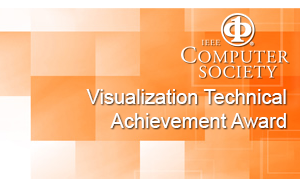 has been awarded the 2005 Visualization Technical Achievement Award by the Visualization and Graphics Technical Committee of the IEEE Computer Society (IEEE VGTC). The award is in recognition of "seminal work on tools for understanding large-scale scientific data sets".
has been awarded the 2005 Visualization Technical Achievement Award by the Visualization and Graphics Technical Committee of the IEEE Computer Society (IEEE VGTC). The award is in recognition of "seminal work on tools for understanding large-scale scientific data sets".This is an international award and is the highest honor and recognition in visualization research. The IEEE VGTC started this award just last year, so Chuck is the second recipient of the IEEE Visualization Technical Achievement Award.
Nvidia Fellowship Awarded
 SCI graduate student Guo-Shi Li was selected among many applications for an Nvidia fellowship. This was a highly competitive process and is a great honor for him. Guo-Shi Li's graduate advisor is SCI faculty member Chuck Hansen.
SCI graduate student Guo-Shi Li was selected among many applications for an Nvidia fellowship. This was a highly competitive process and is a great honor for him. Guo-Shi Li's graduate advisor is SCI faculty member Chuck Hansen.Chris Johnson Testifies Before Senate Sub-Committee
 Chris Johnson, SCI Institute director, testified June 23rd on Capitol Hill before the Congressional Biomedical Research Caucus. His presentation, "Computing the Future of Biomedicine," had a very large turnout, with more than 90 Senate and Congressional Staffers, NIH, NSF and other funding agencies staff, and Congressmen in attendance.
Chris Johnson, SCI Institute director, testified June 23rd on Capitol Hill before the Congressional Biomedical Research Caucus. His presentation, "Computing the Future of Biomedicine," had a very large turnout, with more than 90 Senate and Congressional Staffers, NIH, NSF and other funding agencies staff, and Congressmen in attendance.Rush Holt (Rep. New Jersey) followed up Johnson's presentation with a plea for more funding for fundamental research.
SCI Announces the Publication of "The Visualization Handbook"
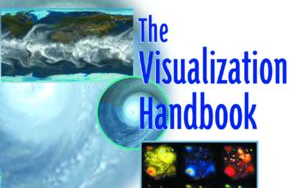 The SCI Institute announces the publication of "The Visualization Handbook," edited by two of SCI visualization faculty, Prof. Charles D. Hansen and Prof. Christopher R. Johnson. This book brings together top experts in the field of scientific visualization to cover state of the art techniques being applied to current scientific problems. A number of the SCI Institute's faculty, research staff, and Ph.D. students have also contributed to the book including Prof. Stephen G. Parker, Prof. Yarden Livnat, Prof. Mike Kirby, Dr. Gordon Kindlmann, Dr. Xavier Tricoche, Joe Kniss, Milan Ikits, and Dean Brederson. Copies may be purchased on the Elsevier web site.
The SCI Institute announces the publication of "The Visualization Handbook," edited by two of SCI visualization faculty, Prof. Charles D. Hansen and Prof. Christopher R. Johnson. This book brings together top experts in the field of scientific visualization to cover state of the art techniques being applied to current scientific problems. A number of the SCI Institute's faculty, research staff, and Ph.D. students have also contributed to the book including Prof. Stephen G. Parker, Prof. Yarden Livnat, Prof. Mike Kirby, Dr. Gordon Kindlmann, Dr. Xavier Tricoche, Joe Kniss, Milan Ikits, and Dean Brederson. Copies may be purchased on the Elsevier web site.
SCI Annouces Certificate Program for Computational Bioimaging
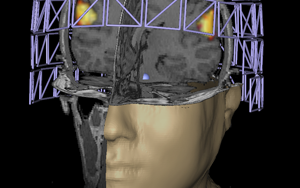 The SCI Institute announces a new graduate level certificate program for Computational Bioimaging. The creation of this multidisciplinary program, involving four academic departments, was funded by the Program for Computational Functional Imaging and Visualization through the NIH/NLBI Biomedical Information Science and Technology Initiative (BISTI). The certificate is considered similar to a Graduate Minor at other universities. Graduate students in the program take classes and fulfill the degree requirements from their home department, as well as take classes in basic physiology, cell biology, radiology, computational science, and image/signal processing. Beginning at an introductory level appropriate for this program, the courses will culminate in a project course where students work in interdisciplinary teams on projects that better reflect the true nature of research problems in computational imagining. Upon completion, each student will receive the certificate in Computational Bioimaging as well as the MS or Ph.D. degree from their home department.
The SCI Institute announces a new graduate level certificate program for Computational Bioimaging. The creation of this multidisciplinary program, involving four academic departments, was funded by the Program for Computational Functional Imaging and Visualization through the NIH/NLBI Biomedical Information Science and Technology Initiative (BISTI). The certificate is considered similar to a Graduate Minor at other universities. Graduate students in the program take classes and fulfill the degree requirements from their home department, as well as take classes in basic physiology, cell biology, radiology, computational science, and image/signal processing. Beginning at an introductory level appropriate for this program, the courses will culminate in a project course where students work in interdisciplinary teams on projects that better reflect the true nature of research problems in computational imagining. Upon completion, each student will receive the certificate in Computational Bioimaging as well as the MS or Ph.D. degree from their home department.For more details on the Computational Bioimaging certificate program.
SCI Professor Wins Paracel Cyclone Cluster
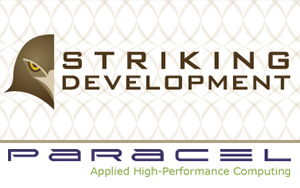 The SCI Institute is pleased to announce that Professor Mike Kirby, faculty member in both the School of Computing and SCI Institute at the University of Utah, is the winner of two AMD Opteron cluster nodes provided by Paracel, Inc*. Paracel, a leading provider of applied high-performance computing systems, offered this two-node Paracel Cyclone* Linux cluster as part of a contest on LinuxHPC.org. Professor Kirby's current research interests are in the development and implementation of computational algorithms for solving problems in computational fluid dynamics, solid mechanics and electromagnetics.
The SCI Institute is pleased to announce that Professor Mike Kirby, faculty member in both the School of Computing and SCI Institute at the University of Utah, is the winner of two AMD Opteron cluster nodes provided by Paracel, Inc*. Paracel, a leading provider of applied high-performance computing systems, offered this two-node Paracel Cyclone* Linux cluster as part of a contest on LinuxHPC.org. Professor Kirby's current research interests are in the development and implementation of computational algorithms for solving problems in computational fluid dynamics, solid mechanics and electromagnetics.
Dr. Johnson Gives Frontiers of Science Lecture
 Dr. Chris Johnson presented a lecture entitled "Computing the Future of Biomedicine" as part of the University of Utah College of Science's Frontiers of Science Lecture series on March 10. In it he discussed the direction of research in Scientific Computing for medicine and some of the great research going on at SCI. The lecture was held at the Aline Wilmot Skaggs Biology Building.
Dr. Chris Johnson presented a lecture entitled "Computing the Future of Biomedicine" as part of the University of Utah College of Science's Frontiers of Science Lecture series on March 10. In it he discussed the direction of research in Scientific Computing for medicine and some of the great research going on at SCI. The lecture was held at the Aline Wilmot Skaggs Biology Building.
First Year ESP Recipients Walk at Graduation
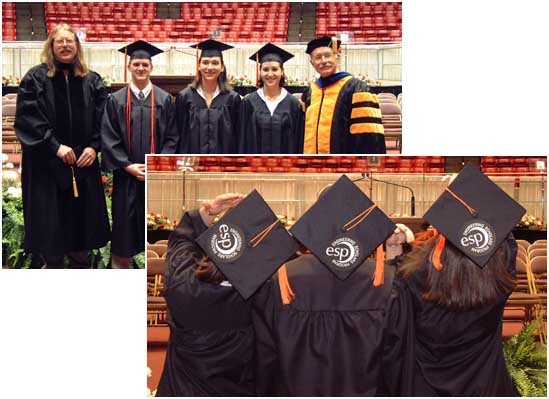 Pictured here are three of our first year scholarship recipients of the Undergraduate Engineering Scholars Program who walked at graduation this May. Darby J Van Uitert, Scott Little, and Rebecca Bott received their degrees from the University of Utah College of Engineering in Computer Science, Electrical Engineering, and Bioengineering respectively.
Pictured here are three of our first year scholarship recipients of the Undergraduate Engineering Scholars Program who walked at graduation this May. Darby J Van Uitert, Scott Little, and Rebecca Bott received their degrees from the University of Utah College of Engineering in Computer Science, Electrical Engineering, and Bioengineering respectively.Established in 1999 by Chris Johnson and the College of Engineering, the Engineering Scholars Program is a scholarship opportunity for incoming freshmen interested in aspects of engineering and computer science. The quest of the ESP is to leverage the exciting engineering-based research at the University by exposing the first year students to actual research activities. The addition of a research component to the first year student's experience allows the student to see over the horizon offered by prerequisite courses. By giving the first year student a more in-depth look into engineering we propose to increase the enthusiasm level of the students with the result being significantly improved retention rates. Higher retention rates translate into a larger and better-trained graduating class of much-needed engineers and computer scientists.
These students are the best and brightest with an average GPA of 3.96 and an average ACT score of 31. Now in its fourth year, the number of scholarship recipients has increased from nine in 1999 to fifteen in 2002.
Steve Parker Accepts Computerworld Honors
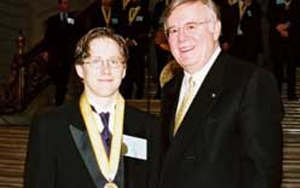 The SCI Institute was recognized April 6th in San Francisco City Hall when it received the Computerworld Honors Medal of Achievement. The award is presented annually to men and women around the world who have made outstanding progress for society through the visionary use of information technology. Nominated by Robert Bishop of SGI for the development of the real time ray tracer, Steve Parker attended the black tie affair and accepted the medal on behalf of the Institute. Dr. Parker is the creator and principle developer of the real time ray tracer. The Star-ray interactive ray tracing system employs a novel approach for generating images of detailed scientific data, allowing users to understand large datasets that overwhelm traditional methods. With increased fidelity rendering, Star-ray can provide interactive exploration of medical, scientific and engineering datasets composed of gigabytes to hundreds of gigabytes of data.
The SCI Institute was recognized April 6th in San Francisco City Hall when it received the Computerworld Honors Medal of Achievement. The award is presented annually to men and women around the world who have made outstanding progress for society through the visionary use of information technology. Nominated by Robert Bishop of SGI for the development of the real time ray tracer, Steve Parker attended the black tie affair and accepted the medal on behalf of the Institute. Dr. Parker is the creator and principle developer of the real time ray tracer. The Star-ray interactive ray tracing system employs a novel approach for generating images of detailed scientific data, allowing users to understand large datasets that overwhelm traditional methods. With increased fidelity rendering, Star-ray can provide interactive exploration of medical, scientific and engineering datasets composed of gigabytes to hundreds of gigabytes of data.Star-Ray is licensed and distributed through Visual Influence inc.




